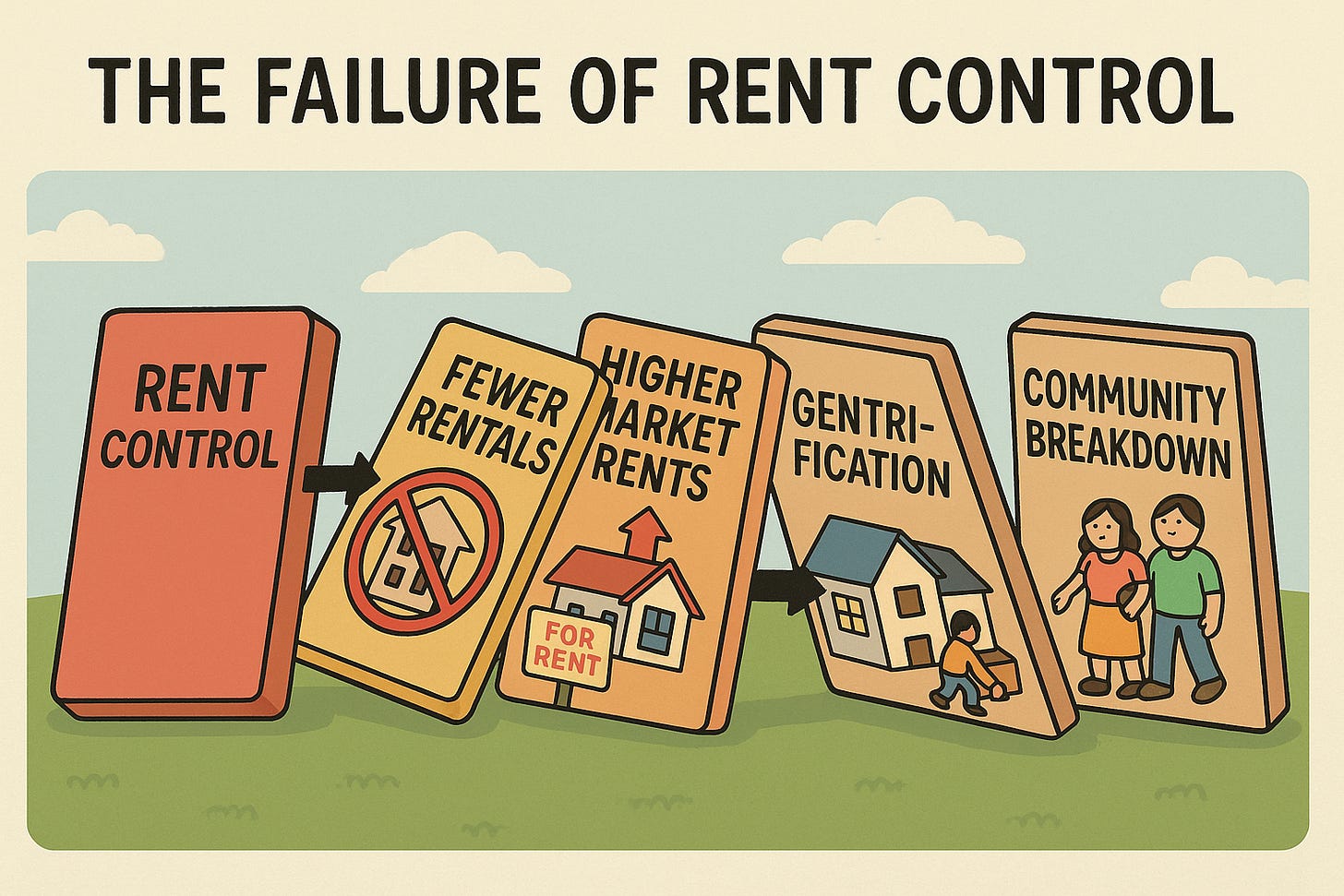6 Ways Rent Control Hurts Californians
Rent control promises affordability but delivers scarcity, higher costs, and community decline, deepening California’s housing crisis.
🕒 5-minute read
The Housing Trap
California families are living through a housing nightmare. We face a shortage of millions of homes, with rents sitting 50 percent above what families pay elsewhere in America. Politicians promise rent control will fix this crisis, but the reality tells a different story. Instead of creating affordable housing, these policies twist market signals, discourage construction, and misallocate housing. Meanwhile, taxpayers foot the bill for enforcement that accomplishes nothing.
When developers see capped returns, they take their investment dollars elsewhere. Tenants compete for an ever-shrinking pool of units. Communities watch neighborhoods stagnate as these misguided policies warp the housing market. Here are six ways rent control makes California’s housing crisis worse for everyone.
1. Discouraging Investment Reduces Housing Supply
Rent control chokes off new housing by sending a clear message to landlords and developers: your investment is not welcome here. In Santa Monica and Berkeley, rental supply dropped 8.7 percent and 7.5 percent, respectively, as frustrated landlords sold their properties or converted rentals to condominiums.
When developers see profits artificially capped, they make the logical choice and build elsewhere. This leaves tenants with fewer options and forces communities to wrestle with a shortage that never gets better. The result is a vicious cycle in which costs keep climbing and access becomes increasingly difficult for ordinary Californians.
2. Driving Up Market Rents for Units Outside of Rent Control
Basic economics tells us what happens when you shrink supply: prices go up everywhere. Santa Monica provides a perfect example. When their rental supply dropped by 8.7 percent, market rents for uncontrolled units rose significantly. Tenants looking for new homes suddenly faced much higher costs.
This creates a two-tier system where some tenants benefit from controlled rents while others pay more. Workers end up moving away from their jobs, disrupting local economies. The affordability crisis deepens for those seeking housing outside the controlled units, while communities lose workers and families who keep neighborhoods vibrant.
3. Neglecting Maintenance Lowers Housing Quality
When the government caps what landlords can charge, property owners look for ways to cut costs. Unfortunately, maintenance is often the first thing to go. In San Francisco, controlled units consistently receive less upkeep, creating substandard conditions for tenants who thought they were getting a good deal.
The ripple effects spread. Property values drop as buildings deteriorate, affecting community stability. Landlords cannot recoup the cost of improvements, so they limit reinvestment. This pushes tenants toward costlier, uncontrolled rentals and creates a downward spiral that makes California’s housing market worse for everyone.
4. Triggering “Cash-for-Keys” Evictions
In Los Angeles’ high-value markets, rent control has created a perverse system where landlords offer “cash-for-keys” deals—sometimes as much as $100,000—to get tenants to leave. While this might sound like a windfall, it disrupts lives by forcing families into much more expensive rentals after they lose their controlled units.
These deals represent a failure of policy. Landlords are paying huge sums to exit unprofitable markets, reducing available units for everyone else. Communities lose long-term residents who provide stability. The practice shrinks California’s rental stock even further, intensifying the housing shortage.
5. Fueling Gentrification and Inequality
Rent control creates an ironic outcome: it accelerates gentrification while claiming to prevent it. Wealthier tenants are better positioned to secure controlled units when availability drops. Berkeley experienced this firsthand when an 8.7 percent drop in available units pushed more affluent buyers into neighborhoods, displacing lower-income residents who could no longer find affordable options.
The system encourages tenants to “hoard” units, staying in places that no longer fit their needs to keep the rent. This locks out newcomers who desperately need housing. Meanwhile, frustrated landlords sell to owner-occupants, shrinking the rental stock for families who cannot afford to buy. Communities lose diversity and limit access for new renters.
6. Increasing Administrative and Legal Costs
Rent control creates a massive bureaucratic apparatus that consumes resources without creating a new housing unit. Santa Ana’s rent control board costs taxpayers $500,000 annually—money that could be used for actual housing solutions. Landlords face constant litigation over tenant protections, raising operating expenses that ultimately get passed on to renters.
Tenants must navigate increasingly complex rules, while communities bear the burden of oversight and enforcement. These costs divert resources from real housing solutions, deepening California’s shortage and straining local budgets.
So, Does It Matter?
California’s progressive left has controlled policy-making for decades, using government’s coercive power to address housing issues through regulation and control. Yet as this evidence shows, rent control laws only deepen our crisis. These policies hurt tenants, landlords, and entire communities while failing to deliver the promised affordability.
To truly address our multi-million-home shortage, state and local governments must recognize rent control as the policy failure it has proven to be. Instead of doubling down on failed approaches, we must prioritize supply-driven solutions to restore affordability and stability across California.



